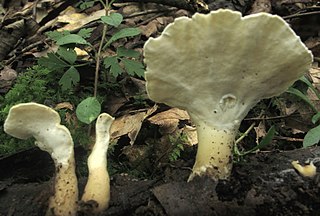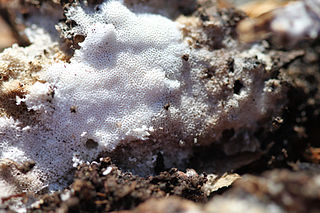Related Research Articles

The Meruliaceae are a family of fungi in the order Polyporales. According to a 2008 estimate, the family contains 47 genera and 420 species. As of April 2018, Index Fungorum accepts 645 species in the family.

The Steccherinaceae are a family of about 200 species of fungi in the order Polyporales. It includes crust-like, toothed, and poroid species that cause a white rot in dead wood.

Antrodiella is a genus of fungi in the family Steccherinaceae of the order Polyporales.

Nigroporus is a genus of poroid fungi in the family Steccherinaceae. The genus was circumscribed by American mycologist William Alphonso Murrill in 1905. Nigroporus has a pantropical distribution. The genus name combines the Latin word niger ("black") with the Ancient Greek word πόρος ("pore").
Antrodia serialiformis is a species of polypore fungus in the family Fomitopsidaceae. The fungus is resupinate, consisting of a fertile spore-bearing pore surface lying flat on the underside of decaying wood, although one or more fan-shaped overlapping caps may also be formed. Although quite common in the eastern United States, it was not recognized as a distinct species until 2009, owing to its resemblance to the closely related Antrodia serialis. Differences in ecology, spore size, and DNA sequences distinguish the two lookalikes.
Antella is a genus of three species of crust fungi in the family Steccherinaceae.
Atraporiella is a monotypic fungal genus in the family Steccherinaceae. It contains the crust fungus Atraporiella neotropica, known only from Belize.
Trulla is a fungal genus in the family Steccherinaceae containing six species of polypores. It was circumscribed by mycologists Otto Miettinen and Leif Ryvarden in 2016, as a continuation of prior work that outlined a revised framework for the Steccherinaceae based on molecular phylogenetics. Its closest relative in the Steccherinaceae is the genus Nigroporus, from which it differs in its light-coloured fruit bodies and monomitic context.
Sebipora is a fungal genus in the family Gelatoporiaceae. It was circumscribed in 2012 by mycologist Otto Miettinen to contain the crust fungus Sebipora aquosa, its single species. This fungus is found in low altitudes in Sumatra and New Guinea, where it causes a white rot on dead angiosperm wood, particularly fallen tree trunks, and frequently on burned wood.

Metuloidea is a genus of five species of fungi in the family Steccherinaceae. The genus was circumscribed by New Zealand-based mycologist Gordon Herriot Cunningham in 1965. The type species is M. tawa, a fungus originally described by Cunningham as a species of Trametes. Formerly classified in family Meruliaceae, Metuloidea was moved to the Steccherinaceae in 2016, following prior research that outlined a revised framework for the Steccherinaceae based on molecular phylogenetics.
Metuloidea murashkinskyi is a species of tooth fungus in the family Steccherinaceae. It is found in Europe and Asia, where it causes a white rot on the wood of deciduous trees.
Caudicicola is a fungal genus in the family Steccherinaceae. The genus was circumscribed by mycologists Heikki Kotiranta, Matti Kulju and Otto Miettinen in 2017 to contain the single crust fungus Caudicicola gracilis. This species is found in Finland, where it grows on the underside of stumps and roots of Norway spruce and Scots pine. The fruit body is fragile and whitish to pale yellow, measuring up to 2.5 mm thick. Its hyphal system is monomitic.

Loweomyces fractipes is a species of poroid fungus in the family Steccherinaceae, and the type species of the genus Loweomyces. It is a widely distributed species, found in North America, Europe, Central America, South America, and Korea.

The Gelatoporiaceae are a small family of crust fungi in the order Polyporales. The family was circumscribed in 2017 by mycologists Otto Miettinen, Alfredo Justo and David Hibbett to contain the type genus Gelatoporia and three other related genera, Cinereomyces, Obba, and Sebipora.
Butyrea is a genus of two species of crust fungi in the family Steccherinaceae.
Metuloidea cinnamomea is a species of tooth fungus in the family Steccherinaceae. Found in the Andes region of Venezuela, it was initially described in 2010 by Teresa Iturriaga and Leif Ryvarden as a species of Antrodiella. Otto Miettinen and Ryvarden transferred it to the newly created genus Metuloidea in 2016.
Trulla dentipora is a neotropical polypore fungus in the family Steccherinaceae, and the type species of the genus Trulla. Characteristics of this species are the irregularly shaped pores with jagged or teeth-like edges, and the sausage-shaped spores. Found in Venezuela, the fungus was originally described by mycologists Leif Ryvarden and Teresa Iturriaga in 2004 as a species of Antrodiella. The type was collected in Henri Pittier National Park, where it was found growing on a hardwood log. Ryvarden and Otto Miettinen transferred the fungus to the newly created Trulla in 2016.
Grammothele bambusicola is a poroid crust fungus in the family Polyporaceae that is found in Asia. It was described as new to science in 1984 by Norwegian mycologist Leif Ryvarden.
Antrodiella lactea is a species of fungus in the family Steccherinaceae. Found in China, it was described as new to science in 2018 by mycologist Hai-Sheng Yuan. The type collection was made in Maoershan Nature Reserve, where it was found growing on a fallen angiosperm branch. The specific epithet lactea refers to the cream-coloured fruit body. The fungus has a trimitic hyphal system, and its generative hyphae have clamp connections. Its smooth, thin-walled spores range in shape from oblong to ellipsoidal, and typically measure 3.1–3.6 by 2.1–2.4 μm.
Antrodiella nanospora is a species of crust fungus in the family Steccherinaceae. Found in China, it was described as new to science in 2018 by mycologist Hai-Sheng Yuan. The type collection was made in Maoershan Nature Reserve, where it was found growing on a fallen angiosperm branch. The specific epithet nanospora refers to its small spores, which measure 2.9–3.2 by 1.8–2.1 μm. The fungus has a dimitic hyphal system, and its generative hyphae have clamp connections. It is similar in appearance to Antrodiella minutispora, but this species has a thicker and fleshier fruit body, larger pores, and does not have cystidioles in the hymenium.
References
- 1 2 Miettinen, Otto; Ryvarden, Leif (2016). "Polypore genera Antella, Austeria, Butyrea, Citripora, Metuloidea and Trulla (Steccherinaceae, Polyporales)". Annales Botanici Fennici. 53 (3–4): 157–172. doi:10.5735/085.053.0403. S2CID 84739655.
- 1 2 Vampola, Peter; Vlasák, josef (2011). "Antrodiella niemelaei, a new polypore species related to Antrodiella americana" (PDF). Czech Mycology. 63 (2): 195–201. doi:10.33585/cmy.63208.